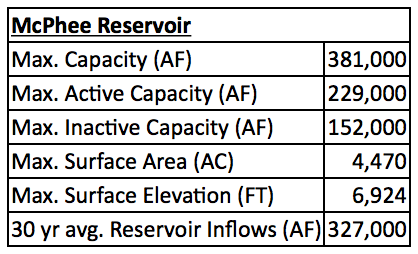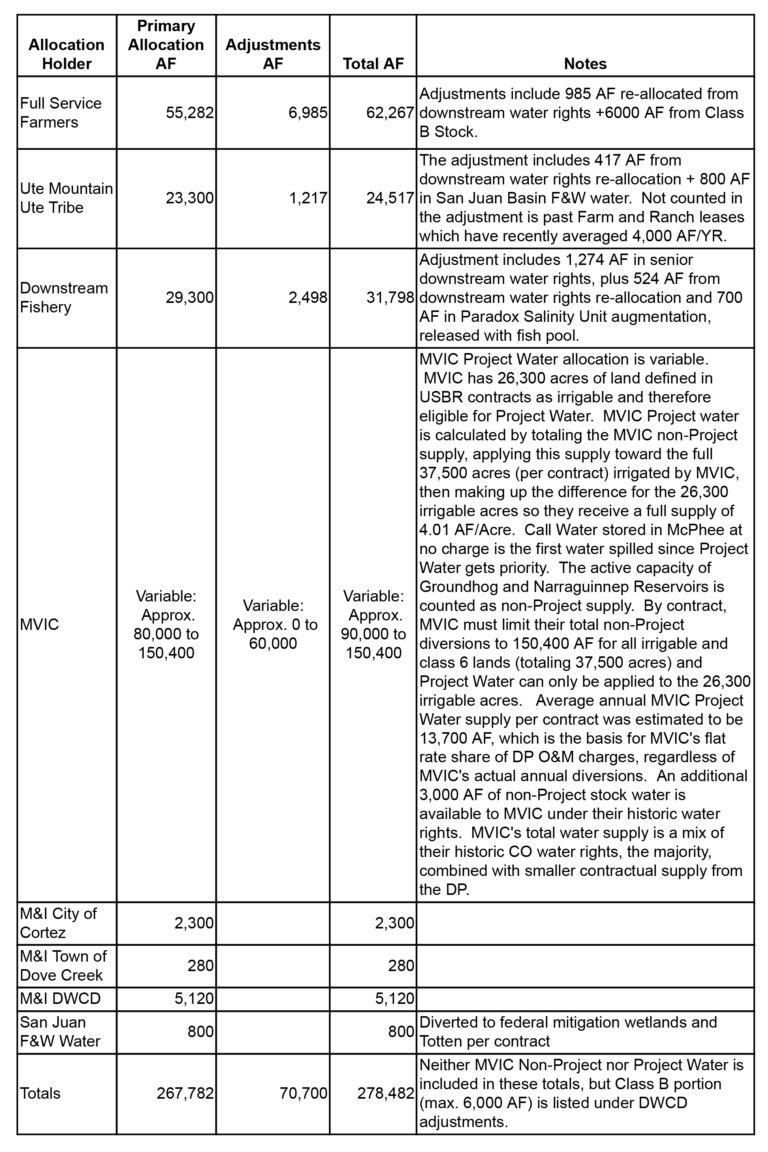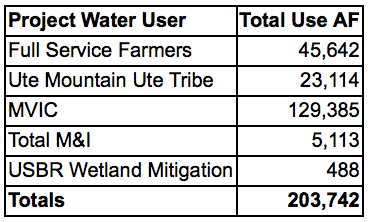FAQ
Quick Reference Table

The following table catalogues the contractual allocations of Dolores Project water as well as any associated adjustments.

When full, McPhee Reservoir covers an area of 4,470 acres. It extends 10 miles up the Dolores River, 4 miles up Beaver Creek, 1 mile up Dry Creek, 2 miles up House Creek, and 2 miles across the Sage Hen flats.
Over the past 30 years, annual inflows into McPhee Reservoir have averaged 327,000 AF. Inflows into the reservoir can vary greatly year to year; in the drought of 2002, annual inflows totaled merely 79,757 AF, whereas just three years later in 2005, recorded inflows were up to 516,457 AF. Inflows are completely sourced in the seasonal snowpack, which is also the primary means of forecasting the annual water supply.
Construction of McPhee Dam began in 1980 and ended in 1986.
The following table summarizes the annual diversions from McPhee reservoir averaged across the last 15 years. Note that there is water released downstream year-round for the fishery as well as semi-regular controlled releases from the dam during the runoff season.

The Dolores Project serves roughly 63,000 irrigated acres within the Project’s Full Service Area (29,000 AC), MVIC’s classified lands (26,300 AC), and the Ute Farm and Ranch Enterprise (7,700 AC).
On average, since the year 2000, the Dolores Project has produced 1,624 AF of municipal water annually.
Historically, McPhee has spilled roughly five in every ten years.
Over the last ten years (2009-2019) the Dolores Project has generated enough power to supply (on average) 2,706 U.S. households year-round, or roughly 25% of the households in Montezuma and Dolores counties.
Mcphee Power Plant runs year round, and Towaoc Power Plant runs from April through September.
TPP – 11.5 Megawatt
MPP – 1.3 Megawatt
This is based on the U.S. Energy Information Administration report of energy usage in the Cortez area for 2017. There are roughly 11,000 households in Montezuma and Dolores counties.
The power produced by the Dolores Project is added directly to Western Area Power Association’s grid.
McPhee Reservoir can hold up to 381,000 acre-feet when full at 6,924 ft in elevation.
The capacity of the reservoir is divided up into three parts:
Dead Pool – 100 acre-feet
Inactive Capacity – 152,000 acre-feet
Active Capacity – 229,000 acre-feet
Zebra and quagga mussels (mussels) are aquatic nuisance species (ANS) that were first confirmed in Colorado in January 2008. The mussels have severe negative impacts on natural resources, fisheries, recreation, economics and water distribution infrastructure for municipal, industrial and agricultural supply.
You can find more information about zebra and quagga mussels through Colorado Parks and Wildlife.
